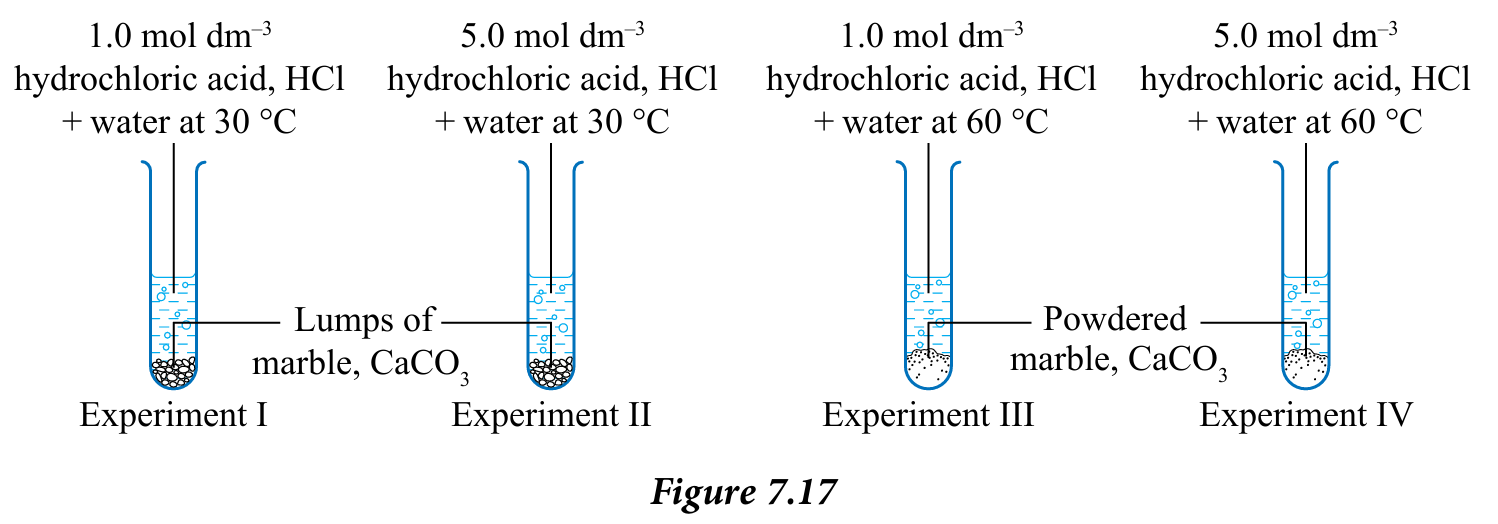Question 1:
The rate of reaction is affected by various factors.
(a) State four factors that would affect the rate of reaction.
(b) Zinc, Zn reacts with excess sulphuric acid, H2SO4 according to the following equation:

State four ways to speed up the reaction. In your answer, state the manipulated and the fixed variables.
Answer:
(a) Concentration of reactant solution, size of reactants, temperature and presence of catalyst.
(b)(i)
Use powdered zinc to replace zinc granules
Manipulated variable : Size of zinc granules
Fixed variable : Temperature, volume and concentration of sulphuric acid, mass of zinc granules
(ii)
Increasing the temperature of sulphuric acid
Manipulated variable : Temperature of sulphuric acid
Fixed variable : Volume and concentration of sulphuric acid, mass and size of zinc granules
(iii)
Increasing the concentration of sulphuric acid
Manipulated variable : Concentration of sulphuric acid
Fixed variable : Temperature, volume of sulphuric acid, mass and size of zinc granules
(iv)
Adding a catalyst
Manipulated variable : Presence of catalyst
Fixed variable : Temperature, volume and concentration of sulphuric acid, mass and surface area of zinc granules
The rate of reaction is affected by various factors.
(a) State four factors that would affect the rate of reaction.
(b) Zinc, Zn reacts with excess sulphuric acid, H2SO4 according to the following equation:

State four ways to speed up the reaction. In your answer, state the manipulated and the fixed variables.
Answer:
(a) Concentration of reactant solution, size of reactants, temperature and presence of catalyst.
(b)(i)
Use powdered zinc to replace zinc granules
Manipulated variable : Size of zinc granules
Fixed variable : Temperature, volume and concentration of sulphuric acid, mass of zinc granules
(ii)
Increasing the temperature of sulphuric acid
Manipulated variable : Temperature of sulphuric acid
Fixed variable : Volume and concentration of sulphuric acid, mass and size of zinc granules
(iii)
Increasing the concentration of sulphuric acid
Manipulated variable : Concentration of sulphuric acid
Fixed variable : Temperature, volume of sulphuric acid, mass and size of zinc granules
(iv)
Adding a catalyst
Manipulated variable : Presence of catalyst
Fixed variable : Temperature, volume and concentration of sulphuric acid, mass and surface area of zinc granules
Question 2:
Four experiments to study the reaction between 2 g of marble, CaCO3 with 15 cm3 of hydrochloric acid, HCl is shown in Figure 7.17.

(a) State the variable that can be observed and measured to determine the rate of reaction.
(b) What is the manipulated variable in the experiment?
(c) Which experiment has the highest initial rate of reaction? Explain your answer.
Answer:
(a) Time for the effervescence to stop or time for all the marble, CaCO3 to fully dissolve.
(b) Concentration of hydrochloric acid, reaction temperature and size of marble, CaCO3.
(c) Experiment IV has the highest rate of reaction because the concentration of hydrochloric acid is higher, the temperature is higher and the size of marble is smaller
Four experiments to study the reaction between 2 g of marble, CaCO3 with 15 cm3 of hydrochloric acid, HCl is shown in Figure 7.17.

(a) State the variable that can be observed and measured to determine the rate of reaction.
(b) What is the manipulated variable in the experiment?
(c) Which experiment has the highest initial rate of reaction? Explain your answer.
Answer:
(a) Time for the effervescence to stop or time for all the marble, CaCO3 to fully dissolve.
(b) Concentration of hydrochloric acid, reaction temperature and size of marble, CaCO3.
(c) Experiment IV has the highest rate of reaction because the concentration of hydrochloric acid is higher, the temperature is higher and the size of marble is smaller
